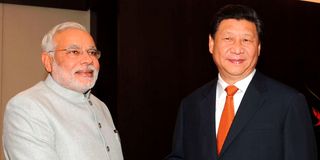Backing free trade obsolete

Indian Prime Minister Narendra Modi (left) shakes hands with Chinese President Xi Jinping during a past BRICS summit in the Brazilian city of Fortaleza. As China’s trade soared, incomes rose seven-fold and extreme poverty declined from 28 per cent to near-zero today.
Supporting free trade is out of fashion. In rich countries, it has been blamed for job losses and all but abandoned by policymakers.
Over the past century, trade had been increasing as a percentage of the global economy. Having peaked around the global financial crisis, it is declining. Regrettably, in Kenya, trade has dropped from 64 per cent of the economy in 2004 to 31 per cent yet freer trade is one of the best development policies.
Trade lifts incomes as it allows a nation to specialise and produce effectively what it does best. A study found trade makes us all 27 per cent richer, meaning countries on average have incomes more than a quarter higher than in a world without trade.
It also lifts the world’s poor out of abject poverty. One of the most cited recent studies found the incomes of the poorest 20 per cent grow as fast as the average.
Look at the world’s two most populous nations, China and India. As China’s trade soared, incomes rose seven-fold and extreme poverty declined from 28 per cent to near-zero today.
India has experienced a similar if more muted, trajectory: When tariffs were reduced from a stifling 56 per cent in 1990 to six per cent in 2020, average incomes rose almost four-fold and extreme poverty declined from 22 per cent to 1.8 per cent. The same case in other fast-growing countries, such as South Korea, Chile and Vietnam. Prosperity from trade really is shared.
Sustainable Development Goals
Little wonder, then, that achieving freer trade is one of the promises world leaders have signed up for with the Sustainable Development Goals (SDGs) for 2030. Sadly, the world is failing on these promises. Leaders promised everything to everyone. Having 169 targets is like having none at all. We are at halftime for the SDGs but nowhere near halfway.
New peer-reviewed research shows why more trade should be at top of the global agenda. The research takes into account the problems of job losses highlighted by rich-world politicians.
It maps out how much additional cost freer trade imposes on these workers through losing their jobs, needing to reskill (often to lower-paying jobs) or leaving the job market altogether. But it uncovers the advantages of more trade, like higher incomes and the consequent improvements for the poor. This makes it possible to weigh the costs and benefits of freer trade.
The ground-breaking study offers the first attempt ever at establishing costs and benefits not just at the global level but also for the world’s rich and poor. The economic model shows that, if we grow global trade by five per cent, the present-day cost for all workers across the world into the future would be $1 trillion. This cost justifies the concern of populist politicians. Yet, the benefits to mankind turn out to be $11 trillion, making this a very good deal.
The people hurt by free trade should be helped more by governments. But the significant surplus from freer trade not only provides a pot of money for it but also presents a big development opportunity to raise incomes and lift people out of poverty.
The new model also shows who bears the costs and demonstrates why rich countries have cooled most on trade. Because rich countries make up the larger part of the global economy, they gain 60 per cent of the $11 trillion. But they suffer more than 90 per cent of the costs. But while this validates some political concerns, it misses the larger picture: Rich countries gain $7 for every dollar of costs.
And it entirely neglects what an opportunity trade is for the poorer half of the world. Their costs are quite minimal, at $15 billion, but benefits run far beyond $1 trillion. For each dollar of loss, the economists find a phenomenal $95 of long-term benefits, increasing incomes and driving down poverty.
To improve the world, we can’t promise everything. We have to do the most efficient policies first, and more trade turns out to be one of the most amazing ways to deliver better lives and incomes.
Dr Lomborg, president of the Copenhagen Consensus, is a Visiting Fellow at Stanford University’s Hoover Institution. [email protected]. @Bjorn-Lomborg https://lomborg.com.





